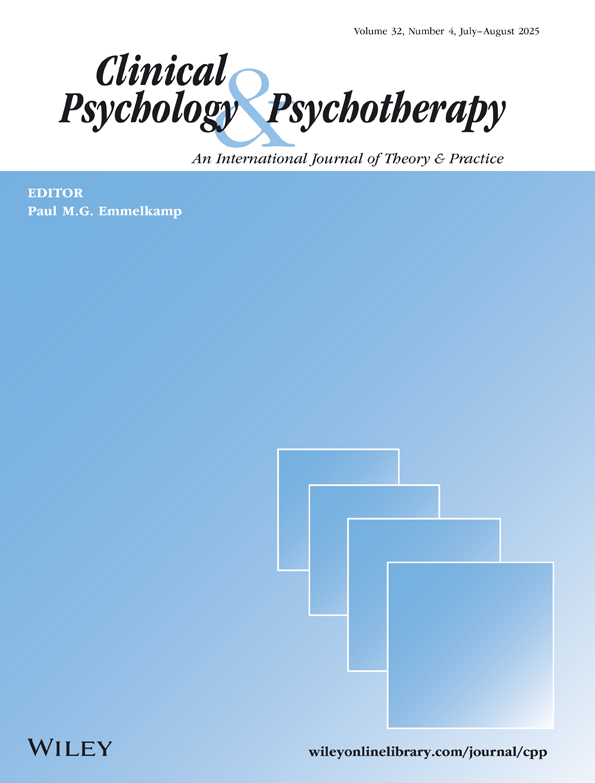The appraisal of threat and the process of selective attention in clinical and sub-clinical anxiety states I: Theoretical issues
Corresponding Author
Tim Dalgleish
Department of Psychology, Institute of Psychiatry and MRC Social and Community Psychiatry Unit, UK
Department of Psychology, Institute of Psychiatry, De Crespigny Park, London SE5 8AF, UKSearch for more papers by this authorCorresponding Author
Tim Dalgleish
Department of Psychology, Institute of Psychiatry and MRC Social and Community Psychiatry Unit, UK
Department of Psychology, Institute of Psychiatry, De Crespigny Park, London SE5 8AF, UKSearch for more papers by this authorAbstract
The present paper is the first of two which seek to integrate the concepts of anxiety and attention within a cognitive framework and assess the empirical evidence which bears on this relationship. The current discussion concentrates on theoretical issues. An initial section examines the concept of attention at what Marr (1982) called the computational level of analysis. This is followed by a discussion of anxiety as a paradigm case within cognitive-appraisal models of emotion, particularly that of Oatley and Johnson-Laird (1987). An integrated framework is then proposed, in which four types of bias in attentional processing associated with anxiety are posited. This is supplemented by a discussion of the concept of self-focused attention.
References
- American Psychiatric Association (1987). Diagnostic and Statistical Manual of Mental Disorders ( 3rd ed. revised). Washington DC: Author.
-
Aristotle
(384–322 B.C./1991).
The Art of Rhetoric.
London:
Penguin.
10.4159/DLCL.aristotle-art_rhetoric.1926 Google Scholar
- Broadbent, D. (1982). Task combination and selective intake of information. Acta Psychologica, 50, 253–290.
- Byrne, D. (1964). Repression-sensitisation as a dimension of personality. In B. A. Maher (Ed.). Progress in Experimental Personality Research. New York: Academic Press.
- Carver, C. S. (1979). A cybernetic model of self-attention processes. Journal of Personality and Social Psychology, 37, 1251–1281.
- Clark, D. A. and Beck, A. T. (1989). Cognitive theory and therapy of anxiety and depression. In P. C. Kendall and D. Watson (Eds), Anxiety and Depression: Distinctive and Overlapping Features. New York: Academic Press.
- Dalgleish, T. and Watts, F. N. (1990). Biases of attention and memory in disorders of anxiety and depression. Clinical Psychology Review, 10, 589–604.
- Easterbrook, J. A. (1959). The effect of emotion on cue utilisation and the organisation of behaviour. Psychological Review, 66, 183–201.
- Ellsworth, P. C. (1991). Some implications of cognitive appraisal theories of emotion. In K. T. Strongman (Ed.), International Review of Studies on Emotion (Vol. 1). Chichester: Wiley.
- Eysenck, H. J. and Eysenck, S. B. G. (1969). The Structure and Measurement of Personality. London: Routledge and Kegan-Paul.
-
Eysenck, M. W.
(1982).
Attention and Arousal: Cognition and Performance.
Berlin:
Springer.
10.1007/978-3-642-68390-9 Google Scholar
- Eysenck, M. W. (1992). Anxiety: The Cognitive Perspective. Hove, England: Lawrence Erlbaum.
- Eysenck, M. W. and Keane, M. T. (1990). Cognitive Psychology: A Student's Handbook. Hove, England: Lawrence Erlbaum.
-
Fodor, J. A.
(1983).
The Modularity of Mind: An Essay on Faculty Psychology.
Cambridge, MA:
MIT Press.
10.7551/mitpress/4737.001.0001 Google Scholar
- Freud, S. (1926/1959). Inhibition, Symptoms and Anxiety. In J. Strachey (Ed. and Trans.) The Standard Edition of The Complete Psychological Works of Sigmund Freud (1953–1974) (Vol. 20). London: Hogarth Press.
- Frijda, N. H. (1986). The Emotions. Cambridge: Cambridge University Press.
- Ingram, R. E. (1990). Self-focused attention in clinical disorders: Review and a conceptual model. Psychological Bulletin, 107, 156–176.
- James, W. (1890/1952). The Principles of Psychology. Chicago: Encyclopedia Brittanica Inc.
- Johnson-Laird, P. N. (1983). Mental Models: Towards a Cognitive Science of Language, Inference and Consciousness. Cambridge: Cambridge University Press.
- Johnston, W. A. and Dark, V. J. (1986). Selective attention. Annual Review of Psychology, 37, 43–75.
- LaBerge, D. (1983). Spatial extent of attention to letters and words. Journal of Experimental Psychology: Human Perception and Performance, 9, 371–379.
- Lang, P. J. (1985). The cognitive psychophysiology of emotion: fear anxiety. In A. H. Tuma and J. Maser (Eds), Anxiety and the Anxiety Disorders. Hillsdale, New Jersey: Lawrence Erlbaum.
- Logan, G. D. (1988). Towards an instance theory of automatisation. Psychological Review, 95, 492–527.
-
Lyons, W.
(1980).
Emotion.
Cambridge:
Cambridge University Press.
10.1017/CBO9780511609244 Google Scholar
- Marr, D. (1982). Vision: A Computational Investigation into the Human Representation and Processing of Visual Information. San Francisco; Freeman.
- Neisser, U. (1976). Cognition and Reality. San Francisco: Freeman.
- Oatley, K. (1992). Best Laid Schemes: The Psychology of Emotions. Cambridge: Cambridge University Press.
-
Oatley, K. and
Johnson-Laird, P. N.
(1987).
Towards a cognitive theory of emotions.
Cognition and Emotion,
1,
29–50.
10.1080/02699938708408362 Google Scholar
- Oatley, K. and Jenkins, J. M. (1992). Human emotions: function and dysfunction. Annual Review of Psychology, 43, 55–85.
- Posner, M. I. (1980). Orienting of attention. Quarterly Journal of Experimental Psychology, 32, 3–25.
- Posner, M. I. and Snyder, C. R. R. (1975). Attention and cognitive control. In R. L. Solso (Ed.), Information Processing and Cognition: The Loyola Symposium. Hillsdale, New Jersey: Lawrence Erlbaum.
- Power, M. and Brewin, C. R. (1991). From Freud to cognitive science: A contemporary account of the unconscious. British Journal of Clinical Psychology, 30, 289–310.
- Shiffrin, R. M. and Schneider, W. (1977). Controlled and automatic human information processing: II. Perceptual learning, automatic attending and a general theory. Psychological Review, 84, 127–190.
- Smith, C. A. and Ellsworth, P. C. (1985). Patterns of cognitive appraisal in emotion. Journal of Personality and Social Psychology, 48, 813–838.
-
Spielberger, C.
(1972).
Anxiety as an emotional state.
In: C. Spielberger (Ed.),
Anxiety: Current Trends in Theory and Research
(Vol. 1).
New York:
Academic Press.
10.1016/B978-0-12-657401-2.50009-5 Google Scholar
- Spielberger, C. D., Gorsuch, R. L. and Lushene, R. E. (1970). The State-Trait Anxiety Inventory (STAI) Test Manual. Palo Alto, California: Consulting Psychologists Press.
- Strongman, K. T. (1987). The Psychology of Emotion ( 2nd ed.) Chichester: Wiley.
- Wachtel, P. L. (1967). Conceptions of broad and narrow attention. Psychological Bulletin, 68, 417–429.




